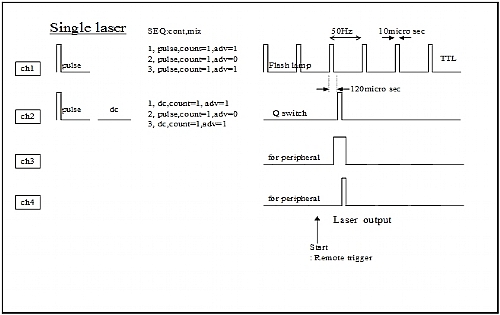Relevant Documents
 (181KB)
(181KB)
Background
A LASER (Light Amplification by Stimulated Emission of Radiation) is an electro-optical device that emits highly coherent light radiation. Lasers have become a multi-billion dollar industry with applications ranging from storage devices to cosmetics.
A laser consists of an energy source, a gain medium and an optical resonator. The energy source, for example a flashlamp, provides the energy to the laser system. The gain medium amplifies the light passing through it, and the optical resonator, usually two mirrors, provides the optical feedback. As light bounces back and forth through the gain medium it is amplified each time. The light that escapes the laser, for example through one of the mirrors, forms the laser beam output.
Some lasers are operated in a continuous fashion, whereas others generate pulses, which can be supplied in a variety of intensities. In the pulsed mode of operation, the output of a laser varies with respect to time, alternating between on and off periods. Often, pulse applications require extremely high energy input levels over a very short period of time.
Requirement
Q-switching is a technique used to perform pulse operations on lasers. Q-switching is achieved by utilizing a variable attenuator called a “Q-switch” inside the laser's optical resonator. When the attenuator is functioning, light which leaves the gain medium does not return, and lasing cannot begin.
Initially, the laser medium is optically pumped while the Q-switch is set to “low Q” in order to prevent feedback of light into the gain medium. As lasing cannot occur at that time, the energy fed into the gain medium by the pumping mechanism accumulates there.
When the stored energy reaches a maximum level (“saturation”), the Q-switch device is quickly reset to “high Q”, allowing feedback of light into the gain medium and initiating the energy emission process. Because of the large amount of energy already stored in the gain medium, the intensity of light in the laser resonator builds up very quickly. This causes the energy stored in the medium to be depleted quickly as well.
The net result is a short pulse of light emanating from the laser, known as a giant pulse, which may have a very high peak intensity and a duration as short as a few nanoseconds.
Operating the laser in pulses demands accurate triggering for both the laser components (flashlamp, Q-switch) and for peripheral equipment such as measuring equipment or cameras, and requires precise synchronization and timing capabilities.
Solution
Tabor Electronics’ Proteus P2584 family of Arbitrary Waveform Generator offers an oustanding solution for laser pulse applications. 4 synchronized output channels, supporting sampling rates of up to 2.5GS/s. Its multi-channel solution allows you to synchronize the activity of the flashlamp, the Q-switch, and peripheral devices, as shown in the diagram in Figure 1 below.

Figure 1: Proteus AWG's Support for Laser Pulse Applications
There is no unit on the market in this price range that can outperform the
Tabor Electronics Proteus P2584 family of Arbitrary Waveform Generator featuring:
-
- 2/4 single ended/differential independent or synchronized output channels.
- Max 9GS/s sample clock rate.
- Up to 9GHz bandwidth.
- 16 bits of vertical resolution.
- Max amplitude of 1.2Vp-p.
- Multiple instrument synchronization.
- Controllable Channel delay and Skew resolution.
- Extremely low noise and excellent spectral purity.
- Up to 16GS of waveform memory.
- Additional up to 16 marker outputs.

Figure 2: The Tabor Proteus Family
Tabor’s Proteus series goes beyond Arbitrary Waveform Generation, as the world’s first Arbitrary Waveform Transceiver. The system integrates the ability to transmit, receive and perform digital signal processing all in a single instrument.
The Proteus series has a PXIe module, desktop or benchtop platform. The modular, compact and cost effective system offers industry leading performance, various configuration options, an innovative task oriented programming, and user programmable FPGA. So, whether it is for Physics, aerospace and defence, telecommunications, automotive or medical. Proteus is the right solution for your project.
For More Information
To learn more about Tabor’s solutions or to schedule a demo, please contact your local Tabor representative or email your request to info@taborelec.com